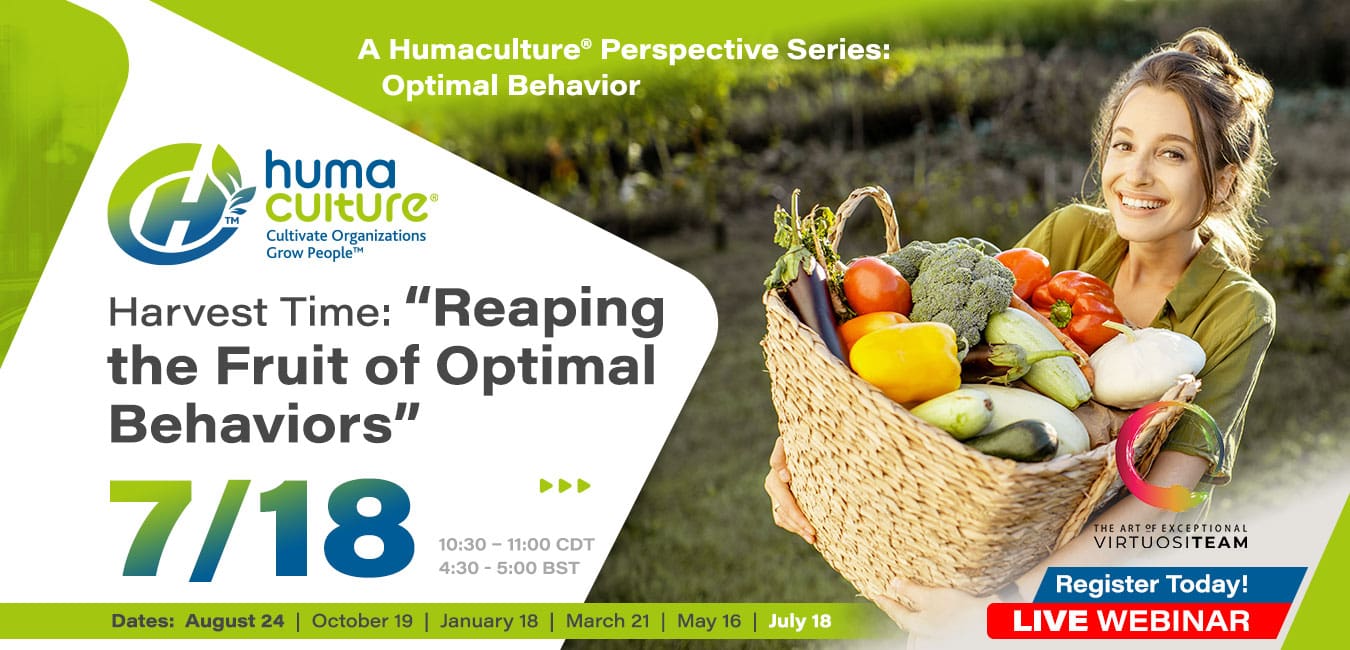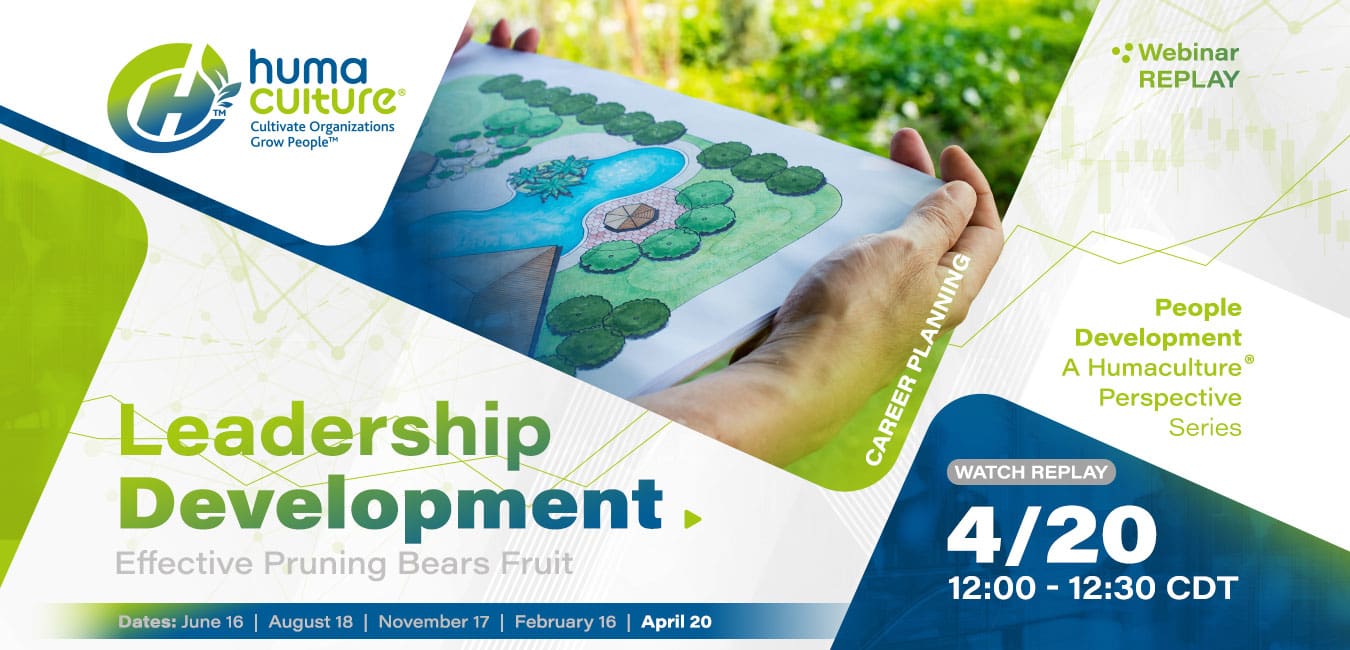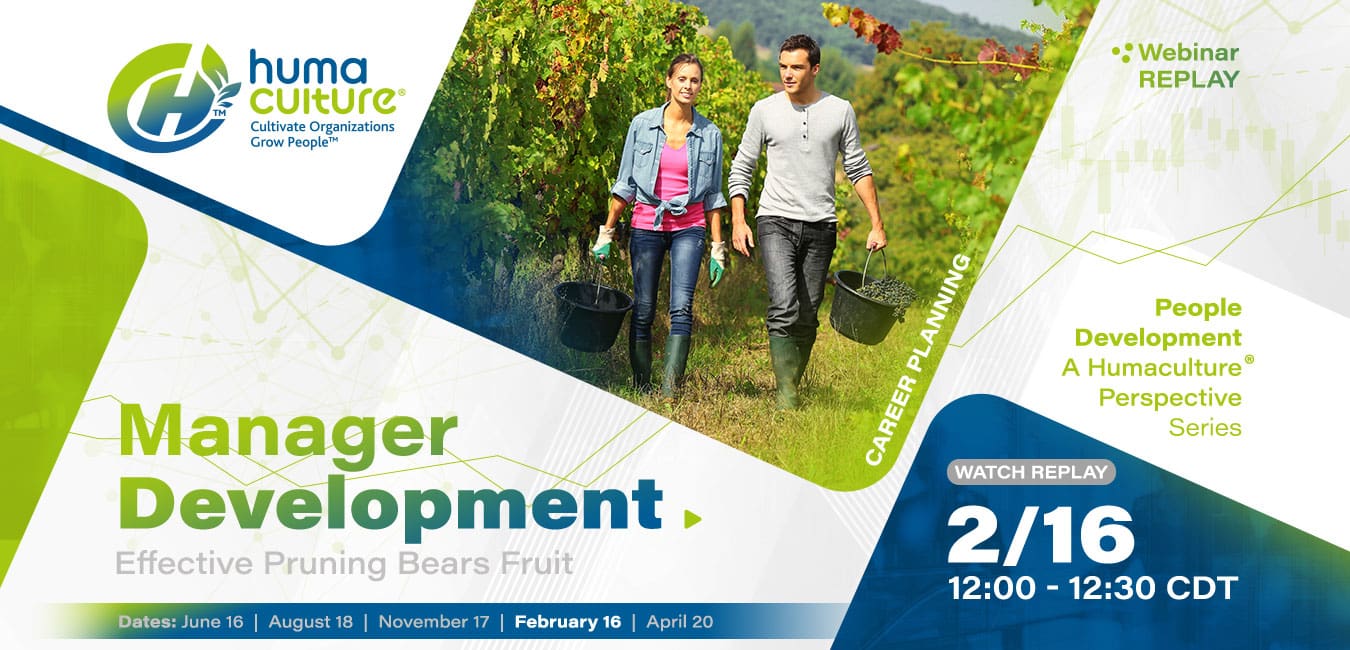Category: Leadership
Harvest Time: “Reaping the Fruit of Optimal Behaviors”

Join us on Thursday, July 18, 2024 from 10:30 to 11:00 CDT (4:30 to 5:00 BST) for the sixth webinar in Humaculture, Inc.’s “Optimal Behavior: Making Optimal Behavior the Natural Choice.” You will learn why and how to apply the four Contexts and four Powers of behavior change through a review of a case example.
Presenters
- Steve Cyboran, ASA, MAAA, FCA, CEBS, actuary and strategy consultant
- Wes Rogers, Humaculturist® and strategy consultant
- Colin Bullen, ASA, behavior change actuary
- Hanlie van Wyk, behavior change consultant
Objective
In this sixth and final session in our series on Optimal Behavior, we explore how to apply all the learning from the previous five webinars to reap a bountiful harvest produced by desired behaviors. To reliably achieve sustained Optimal Behavior, we consider all four Contexts – Spaces, Self, Systems, and Social. We do this by applying the Four Powers – the Powers to grow capability, inspire motivation, overcome barriers, and resist temptation – to align the influences acting on People toward supporting the change to Optimal Behavior. We will demonstrate the process of adjusting the Powers within the Contexts and the practical steps to take using a case study in the retail sector. We wrap up with the virtuous cycle that is the Change Ecosystem, showing how to reinforce Optimal Behaviors and ensure those behaviors stick. At the end of this webinar, attendees will understand how the Powers and Contexts come together to create the Four Powers behavior change framework and how that framework can be applied in practice.
“In the final analysis, change sticks when it becomes the way we do things around here.” – John P Kotter
Harvest Time Key Takeaways
Join us to learn how to apply the Four Powers model of change to reap the following fruits:
- Confident and capable People
- Inspired workplace
- Agile workforce
- People armored against distractions
Available Support
We are available to support you in your strategy, design, compliance, financial, and monitoring needs. Our team includes business and human relations leaders, finance experts, actuaries, clinicians, behavioral health experts, pharmacy experts, and legal resources to guide you through the strategy and compliance process. Please contact us: [email protected].
Webinar Replay: Effective Pruning Bears Fruit: Leadership Development

Watch a replay of the fifth webinar in Humaculture, Inc.’s “People Development: A Humaculture® Perspective Series” to learn how to conduct Career Planning to support leadership development, and why “Effective Pruning Bears Fruit” by building leadership capabilities.
Presenters
- Steve Cyboran, ASA, MAAA, FCA, CEBS, actuary and strategy consultant
- Wes Rogers, Humaculturist® and strategy consultant
- Christi Green, RN, MS, PHR, strategy and people consultant
Objective
We’ve talked about how to develop managers to lead to growth and new directions as opposed to staying rooted in the current problems. Now this webinar focuses on how to develop leaders to advance strategy, focus on people, and inspire performance. This results in leadership cultivating the organizational “soil” which leads to real, practical changes that advance the business.
Career Planning: Leadership Development Key Takeaways
During this session, participants will learn that:
- Leaders fail to make decisions
- Leadership vacuums create confusion and a toxic environment
- Leaders who lack a broad perspective undermine operations
- For effective leadership development organizations must:
- Understand effective leadership qualities
- Build and cultivate the right organizational “soil”
- Develop leaders who have good intuition and decision-making skills
- Ensure well-rounded leadership team with appropriate autonomy
- Nurture and develop for intended purposes
Available Support
We are available to support you in your strategy, design, compliance, financial, and monitoring needs. Our team includes business and human relations leaders, finance experts, actuaries, clinicians, behavioral health experts, pharmacy experts, and legal resources to guide you through the strategy and compliance process. Please contact us: [email protected].
Watch
Watch the Career Planning: Effective Pruning Bears Fruit: Manager Development Webinar Replay via Rumble or YouTube.
Career Planning: Effective Pruning Bears Fruit: Leadership Development

Join us on Thursday, April 20 from 12:00 to 12:30 CDT for the fifth webinar in Humaculture, Inc.’s “People Development: A Humaculture® Perspective Series.” You will learn how to conduct Career Planning to support leadership development, and why “Effective Pruning Bears Fruit” by building leadership capabilities.
Presenters
- Steve Cyboran, ASA, MAAA, FCA, CEBS, actuary and strategy consultant
- Wes Rogers, Humaculturist® and strategy consultant
- Christi Green, RN, MS, PHR, strategy and people consultant
Objective
Last webinar, we talked about how to develop managers to lead to growth and new directions as opposed to staying rooted in the current problems. Now it’s time to talk about how to develop leaders to advance strategy, focus on people, and inspire performance. This results in leadership cultivating the organizational “soil” which leads to real, practical changes that advance the business.
Career Planning: Leadership Development Key Takeaways
During this session, participants will learn that:
- Leaders fail to make decisions
- Leadership vacuums create confusion and a toxic environment
- Leaders who lack a broad perspective undermine operations
- For effective leadership development organizations must:
- Understand effective leadership qualities
- Build and cultivate the right organizational “soil”
- Develop leaders who have good intuition and decision-making skills
- Ensure well-rounded leadership team with appropriate autonomy
- Nurture and develop for intended purposes
Webinar Replay: Effective Pruning Bears Fruit: Manager Development

Watch a replay of the fourth webinar in Humaculture, Inc.’s “People Development: A Humaculture® Perspective Series” to learn how to conduct Career Planning to support manager development, and why “Effective Pruning Bears Fruit” by building manager capabilities.
Presenters
- Steve Cyboran, ASA, MAAA, FCA, CEBS, actuary and strategy consultant
- Wes Rogers, Humaculturist® and strategy consultant
- Christi Green, RN, MS, PHR, strategy and people consultant
Objective
We’ve talked about how to “Effectively Prune” to activate and inspire our workplace AND workforce to further grow and develop employees. Now this webinar focuses on how to develop managers to facilitate growth instead of control, to focus on people in addition to results, and to be vision driven instead of a problem solver. This leads to growth and new directions as opposed to staying rooted in the current problems.
Career Planning: Manager Development Key Takeaways
During this session, participants will learn that:
- Organizations fall into the “star” employee syndrome
- Organizations don’t think from a people development perspective
- Culture of Control creates a toxic environment
- For effective manager development organizations must:
- Promote intentionally to fulfill vision, mission, values
- Effectively identify manager qualities/potential
- Develop and deploy learning and growth opportunities
- Shift from Culture of Control to Culture of Growth
- Prepare for appropriate transitions
Available Support
We are available to support you in your strategy, design, compliance, financial, and monitoring needs. Our team includes business and human relations leaders, finance experts, actuaries, clinicians, behavioral health experts, pharmacy experts, and legal resources to guide you through the strategy and compliance process. Please contact us: [email protected].
Watch
Watch the Career Planning: Effective Pruning Bears Fruit: Manager Development Webinar Replay via Rumble or YouTube.
Career Planning: Effective Pruning Bears Fruit: Manager Development

Join us on Thursday, February 16 from 12:00 to 12:30 CDT for the fourth webinar in Humaculture, Inc.’s “People Development: A Humaculture® Perspective Series.” You will learn how to conduct Career Planning to support manager development, and why “Effective Pruning Bears Fruit” by building manager capabilities.
Presenters
- Steve Cyboran, ASA, MAAA, FCA, CEBS, actuary and strategy consultant
- Wes Rogers, Humaculturist® and strategy consultant
- Christi Green, RN, MS, PHR, strategy and people consultant
Objective
We’ve talked about how to “Effectively Prune” to activate and inspire our workplace AND workforce to further grow and develop employees. Now it’s time to talk about how to use management to grow instead of control, focus on people in addition to results, and be vision driven instead of a problem solver. This leads to growth and new directions as opposed to staying rooted in the current problems.
Career Planning: Manager Development Key Takeaways
During this session, participants will learn that:
- Organizations fall into the “star” employee syndrome
- Organizations may not think from a people development perspective
- Culture of Control creates a toxic environment
- For effective manager development organizations must:
- Promote intentionally to fulfill vision, mission, values
- Effectively identify manager qualities/potential
- Develop and deploy learning and growth opportunities
- Shift to a Culture of Growth with accountability
- Prepare for appropriate transitions
Leadership & Tomatoes: 3 Business Principles from My Garden

About 1 in 3 people aspire to a leadership role in business.1 About 1 in 3 people grow a kitchen garden.2 The motivation is the same with both demographics. What is it? The tomatoes, of course. Business success. The harvest.
In turn, successful businesses and successful gardens also have something in common: the people who are rooting (pun intended) for it all to be a thriving ecosystem, resulting in a bountiful harvest for everyone.
Over the years, I have observed that many horticulture principles can provide insights and understanding to help those in leadership build more successful organizations.
Leadership Principle #1 — First build the soil.
Without first building healthy soil, gardening is unlikely to be successful. Well-prepared, deep garden soil gives plants the best opportunity to grow a strong root system.

In my garden, I till the soil each spring while the temperatures are still dipping below freezing. I add compost, fall leaves, and grass clippings to add nutrients and texture to the soil. I add alkaline wood ash from winter fires to maintain the soil’s pH balance, since I know my iron-laden well water tends to acidify the soil over time.
Well-prepared soil ensures the plants have the nutrients they need. Good soil also maintains a more consistent temperature, and it allows excess water to drain away faster, retaining only a healthy amount of moisture and retaining it longer.
If we think of businesses and organizations as the soil in which we grow and earn our living, we can easily begin to see parallels between a garden and an organization. An organization that is well prepared has sufficient capitalization, delivers products and services consistent with its vision and mission, is conducive to employee health and well-being, has reserves to weather economic storms, etc.
Most new businesses fail because those who form them are focused primarily on the success they hope to achieve (i.e. harvesting a bumper crop of metaphorical tomatoes), rather than first focusing on the soil preparation that will be critical to that success.
Leadership Principle #2 — Support the plants as they grow.
Once the soil is prepared, the hardest work is done. I have created a nutrient-rich, foundational environment the tomato plants can send deep roots down into and draw resources from to thrive.

In addition to building the soil, I also have further resources to ensure the tomatoes’ success. I supply supports for the plants as they grow taller and bend under the weight of their fruit. I provide irrigation, giving plants the extra water they need in the dry summertime. I walk through the garden almost every day to identify stressors affecting the plants so I can intervene with extra support if necessary.
Employees—even those in the best-prepared organizational soils—will experience negative stressors and challenges from time to time. Distressed tomato plants, just like people experiencing excessive stress, will never be as productive as they would be if they were healthy, and the quality of what they produce will likely be lower as well. Like a horticulturist walking through the garden, a person in a leadership position needs to be able to recognize when something is preventing the employees within their span of care from fully thriving.
Perhaps the employee is not well-matched to the job; they might benefit from transplanting to another area of the organization. Perhaps some benefits, compensation, recognition and performance management programs, advancement pathways, etc. are not properly designed to align with the organizational vision or mission; more beneficial behavioral designs could be put in place instead. Perhaps there are organizational climate challenges; the team might need special support during especially trying times to overcome the difficulties and thrive.
Often, the problem lies not with the employee, but with the organization and whether it optimizes the availability of its resources so employees can effectively leverage them and thrive.
Leadership Principle #3 — Plants don’t exist for soil; soil exists for plants.
The primary focus of a successful garden is never actually the plants. Plants come and go. If they are happy and healthy in well-built soil, they will thrive and produce a great crop.
Yet I never think of my tomato plants as resources to be exploited. Rather, in partnership and anticipation, I provide them with great soil and support them as they grow and produce. Most of my effort is directed into building the soil for the plants and making sure they have everything they need to thrive; the plants themselves do the rest. Both my tomatoes and I work in this gardening venture, looking ahead to the reward – a bountiful harvest.
One of the most important lessons I have learned from gardening is that just as the plants do not exist for the soil, people do not exist for the organization. Employees—humans—are not “resources” or “capital.” In fact, these terms have come to bother me deeply. “Capital” and “resources” are things an organization owns, rents, or acquires through debt to produce a product or deliver a service. Grouping people into a category of owned or rented assets is very discomforting to the thoughtful person.
Further, I have observed that developing policies and practices based on the analogy of owning or renting people (as the capital/resources terminology implies) leads to confusion on many fronts. Ultimately, it often leads to employees who are demoralized and perform poorly.
So, what if we thought of businesses and organizations as soil created for people to grow and thrive in? What if we thought of the organization’s resources as the support people need to produce abundant value (the harvest)? Organizations do not own employees. Employees are not the resource. Organizations are the soil in which people can root themselves to do meaningful, fruitful work – to grow and to thrive.
Just like I build the soil for my tomato plants because they grow better in a prepared garden, people create organizations of all sorts because we grow better and accomplish more together.
Practical Applications
So, if we change the way we think about organizations and people, how do we also rethink the way leadership handles traditional “human resources” or “human capital” topics (e.g. pay, talent development, performance management, benefits, time off, total rewards, etc.)? In other words, what is the practical application of these principles?
The Humaculture® approach addresses this. In order to apply the concept of building the soil, we first have to ask some questions: Why does the organization exist? What is its vision? In what sort of climate does the organization operate?
After gaining some clarity about these factors, the Humaculture® approach leads us to consider which people will best achieve the organization’s vision and mission (peach trees are unhelpful if the goal is a tomato crop, just as nurses are unlikely to design the best engine for a cutting-edge vehicle prototype).
The Humaculture® approach also leads us to consider what structure and delivery of the organizational resources will allow the people—and, in return, the organization—to thrive and be abundantly fruitful.
It might seem like more work at the outset, but the tomatoes (the fruit, the value created) are always worth it.

1 http://press.careerbuilder.com/2014-09-09-Majority-of-Workers-Dont-Aspire-to-Leadership-Roles-Finds-New-CareerBuilder-survey
2 http://www.farmerfoodshare.org/farmer-foodshare/2017/6/15/gardening-boom-1-in-3-american-households-grow-food
Author:
Wes Rogers, Chief Guidance Officer for Humaculture, Inc. Wes has almost 35 years’ experience in consulting and senior management positions with a variety of organizations, facilitating groups of people with diverse perspectives and objectives to coalesce around a singular vision and marshal resources to achieve the vision. This experience provides exceptional insights into how organizations operate and succeed. Contact Wes at [email protected].
Contributor:
Steve Cyboran, ASA, MAAA, FCA, CEBS, Chief Behavioral Officer, Consulting Actuary for Humaculture, Inc. Over the past 30 years, Steve has worked extensively with leading corporations, higher education institutions, and health systems across the country to articulate a vision for a healthy and effective workplace culture, develop a total rewards strategy to support that vision and brings deep benefits expertise with a behavioral approach and sound analytics to achieve and measure the desired outcomes. Contact Steve at [email protected].
Edited by:
Rachel Rogers, Editor for Humaculture, Inc. Rachel holds an A.A. in Liberal Studies with an emphasis in English and Communications. As a published writer with training in creative storytelling and corporate storytelling, her experience with writing, editing, and advising writers includes both technical and academic documents, as well as creative works.
About Humaculture, Inc.
Humaculture, Inc. transforms organizations—the way organizational leaders understand the organization and the relationships among the people in it, and the way people think about their position and role in the organization. Humaculture® is a philosophy and systematic approach for creating profitable, aligned, and healthy organizations conceptualized as “soil” in which people can thrive. Humaculture® helps organizations create the right culture in order to naturally attract, retain, sustain, grow, and transition people who enable the business—and each other—to thrive. More information can be found at: Humaculture.com.
Weathering the Storm: Is Your Organizational “Soil” Healthy Enough to Weather Both Floods and Droughts?

During these unprecedented times with businesses having been shut down due to an outside order by the government in response to COVID-19, many sectors of the economy, labeled as “non-essential,” were ordered to close business for a period. Organizations that are highly leveraged (a significant portion of the revenue is used to pay debt) or in lower margin businesses face an even greater challenge. Organizations need to figure out how to weather the storm. These options may include reduction in force to rolling furloughs, and potentially reorganizing through bankruptcy. What is the right decision for your organization?
If we think about an organization like the soil, the employees like plants growing in the organization, and the fruit they bear as the value or profit of the organization, then horticulture can provide a good analogy from which to view options for addressing the current situation. From a horticultural perspective, the current “storm” is like a drought. The first thing a horticulturist might do, for example, when faced with a drought is add mulch and preserve soil moisture, not jerk plants out of the garden. As another example, during an unexpected late freeze, it may become necessary to cover plants to enable them to maintain their heat.
“It is not nice to garden anywhere. Everywhere there are violent winds, startling once-per-five-centuries floods, unprecedented droughts, record-setting freezes, abusive and blasting heats never known before. There is no place, no garden, where these terrible things do not drive gardeners mad.” Henry Mitchell, author of the Essential Earthman
When weighing options to reduce costs and capacity such as layoffs, furloughs, rolling unpaid time off, treatment of unused PTO, leadership needs to weigh several considerations. For example,
Culture – One of the most important considerations may be how the organization wants to come out of this trying time. The approach may vary depending on the type of culture currently in place. For example:
- Strong, Productive Culture and Balance Sheet – If an organization has a strong, productive culture, with good talent and is financially strong enough to weather the current challenges (e.g., well prepared, fertile soil, that is more resilient), layoffs can be one of the most detrimental actions an organization can take to the long-term health of the organization and its people. There will be a drain on talent that may later be needed to support a strong recovery for the business, and that talent may wind up joining, or starting, competitors and taking a certain portion of knowledge with them. Layoffs made too hastily, where the remaining jobs aren’t redesigned to accommodate the reduction in staff and pick up the essential tasks of those leaving, may result in the need to rehire many of those positions. Then the organization assumes the cost of the layoff, and training of the new hires for the same positions, without any long-term value gain. In addition to considering the impact of the loss of talent from layoffs, the organization should budget for an increase in health, absence, and disability costs. We have seen 5% to 10% unanticipated increase in these costs depending upon the size and nature of the restructuring. The implications of a layoff may have long term impact that may make the long-term cost not worth the short-term gain. Other considerations may achieve the same goal while preserving the culture and health of the organization and its people.
- Culture is In Need of a Refresh – On the other hand, if there has been a need to rethink the culture and business structure (remove plants not well-suited for the garden, transplant some to different soil, and prune existing plants to shape them to be more productive), then it may make sense to consider some form of restructuring of the leadership and/or workforce. This can present a great opportunity to accomplish the organizational change that has been desperately needed but deferred. The type and nature of the restructuring may depend upon the suitability of the employees to achieve the business strategy. Organizational leaders should consider aspects of both cultural alignment and cultural health. A few examples (certainly not comprehensive) to consider may include:
- Working Retired – If there is a segment of the workforce at normal retirement age that may still be employed, but lack the energy and commitment necessary to take the organization where it needs to go. Then the organization may get more energy and innovation from a younger, less costly resource. In this case, an early retirement window may make sense. One client has a location where 70% of the workforce is retirement eligible and has the highest labor costs, but the employees are unprepared and afraid to retire. An early retirement window may be beneficial to those eligible for retirement and the organization.
- Strategically Misaligned – If there are certain businesses or shared service segments that may not be a good strategic fit (not directly driving the strategic priorities of the organization), then the organization may consider selling off, outsourcing, or co-sourcing those functions. For example, if your business is higher education, an outsourced food services contract affords greater flexibility during periods where the campus is shut down.
- Re-alignment – If there are opportunities to automate, streamline, or eliminate positions, then the organization may need to restructure. If the organization chooses this route, it is important that jobs are redesigned to ensure important functions don’t fall through the cracks, that you have the right talent in those positions, which may involve “transplanting” employees to other areas of the organization, and retraining or hiring different talent. Some of our clients have worked with a management consulting firm to evaluate staffing ratios to determine how many people should be appropriate. Following those recommendations, the client reduces staffing levels as indicated, but without redesigning the remaining jobs, they must often rehire those positions because critical work isn’t getting done.
Temporary Nature – Organizations will also need to consider if, and to what extent, this challenge will be a short term. If this will only be a temporary set-back and demand is simply deferred (e.g., delayed purchases such as iPhones, or elective procedures), or even if business will rebound to similar levels of activity from prior to the current downturn, then the organization may want to consider more of a shared responsibility approach with rolling unpaid time off or even furloughs. With the right messaging, the organization may be able to enhance its relationship with employees, letting them know the organization doesn’t want to let any of its teammates go during these challenging times, so we all need to consider ways to save money and share in the sacrifice. However, with 40% of the workforce living paycheck to paycheck[1], they may need to consider the potential impact on the financial well-being of the workforce if they are asked to work less (for example, 20% reduction in hours, and a corresponding 20% pay cut).
“My heightened awareness of stewardship to those within my span of care gave me a clear sense of purpose and clarity through which to view the situation. I thought to myself: We’re a family at Barry-Wehmiller so we need to act like one. What would a responsible family do in this crisis? A loving family would share the burden. Rather than watching a few of our colleagues face devastation, we decided that our reaction would be one of shared sacrifice.” Bob Chapman, CEO of Barry-Wehmiller
Other Cost Saving Opportunities – There are a number of dials in the various reward programs that can be considered. For example, time off programs can be leveraged to save cost and moderate the capacity of the workforce. The time off policies, and other state and local regulations, often drive a number of cost considerations, such as:
- Do you pay out unused PTO upon termination or at the end of the year?
- How does time accrue (e.g., front-load, weekly accruals)?
- To what level and extent should time accrue, or temporarily stop accruing during an economic downturn?
- What is the right level and balance between scheduled time off (PTO/vacation/holidays) vs. unscheduled time off (sick leave, disability, emergency)?
While there may be pressure to make rash decisions to lay people off for quick cost savings to preserve the profitability of the organization, take a step back and consider alternatives that may be similarly impactful, but preserve the “tilth” of the organization for the future.
Authors:
Steve Cyboran, ASA, MAAA, FCA, CEBS, Chief Behavioral Officer, Consulting Actuary for Humaculture, Inc. Over the past 30 years, Steve has worked extensively with leading corporations, higher education institutions, and health systems across the country to articulate a vision for a healthy and effective workplace culture, develop a total rewards strategy to support that vision and brings deep benefits expertise with a behavioral approach and sound analytics to achieve and measure the desired outcomes. Contact Steve at [email protected].
Wes Rogers, Chief Guidance Officer for Humaculture, Inc. Wes has almost 35 years’ experience in consulting and senior management positions with a variety of organizations, facilitating groups of people with diverse perspectives and objectives to coalesce around a singular vision and marshal resources to achieve the vision. This experience provides exceptional insights into how organizations operate and succeed. Contact Wes at [email protected].
About Humaculture, Inc.
Humaculture, Inc. transforms organizations, the relationship with their people, and how they think about their people. Humaculture® is a philosophy of, and systematic approach to, creating profitable, aligned, and healthy organizations conceptualized as “soil” in which people can thrive. By creating the right culture, the organization naturally attracts, retains, sustains, grows, and transitions people who enable the business to thrive. More information can be found at: Humaculture.com.
[1]Research from the Federal Reserve found that 4 in 10 Americans couldn’t afford a $400 emergency, and 22% say they expect to forgo payments on some of their bills (https://www.marketwatch.com/story/half-of-americans-are-just-one-paycheck-away-from-financial-disaster-2019-05-16).
